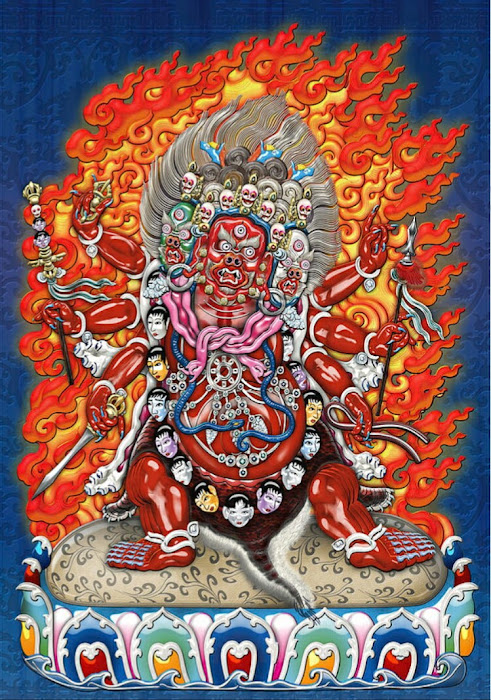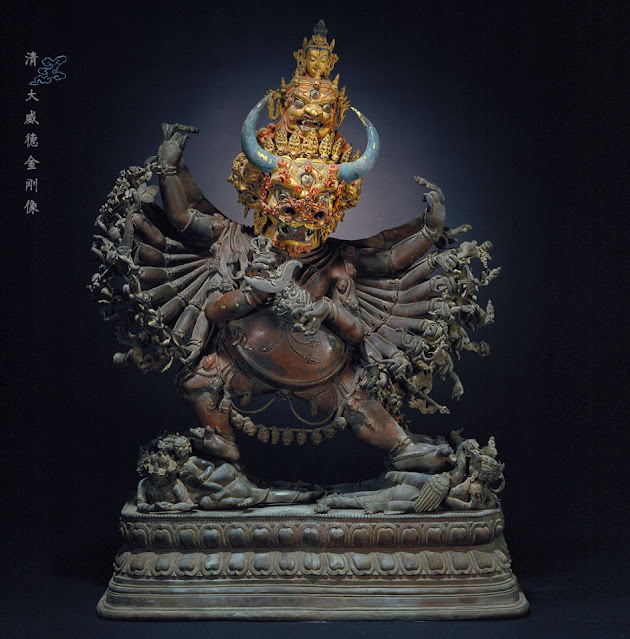Heruka ( Sanskrit ) Tibetan: ( Khrag Thung), is the name of a category of wrathful deities, enlightened beings in Vajrayana Buddhism that adopt a fierce countenance to benefit sentient beings. In East Asia, these are called Wisdom Kings.
Herukas represent the embodiment of indivisible bliss and emptiness. They appear as Istha-devata (Tibetan: Yidam) or meditational deities for Tantric Sadhana, usually placed in a mandala and often appearing in Yab-Yum.
Heruka represents wrathful imagery with indivisible emptiness (Sunyata), bliss, peace, wisdom, compassion (Bodhicitta), and love. Herukas represent unified consciousness, with emptiness being a reflection of "non-phenomena" or emptiness which is "all love," or removal of imagery to reach universal love, mercy, and compassion-mind. Interpretation of Heruka is similar to the female Dakiṇi or Buddha Vajrayogini.
The Nyingma mahayoga tradition (and their corresponding sadhanas) are said to have been received by Padmakara from the Eight Vidyadharas or Eight Great Acharyas: Manjushrimitra, Nagarjuna, Vajrahumkara, Vimalamitra, Prabhahasti, Dhanasamskrita, Shintamgarbha and Guhyachandra. They were proficient in the practices of, respectively:
(No.5) Vajrakilaya/Vajrakumara (Tibetan: Dorje Phurba) the wrathful Vajrasattva, the deity of purification. Vajrakilaya is a wrathful manifestation of Vajrasattva, the Buddha of purification. This powerful practice of Vajrakilaya focuses on removing outer and inner obstacles to happiness, peace, bliss, and enlightenment.
Vajrakilaya, also called Vajrakila and Dorje Phurba, is a wrathful Tantric meditation deity whose practices are most often performed by the disciples of the Nyingma order. Vajrakilaya's practices are particularly effective methods for removing obstacles and obstructions, and for destroying and purifying negative forces.
Vajrakilaya embodies the powerful enlightened activity of all the Buddhas, and his special emblem - the ritual phurba dagger - represents the sharp point of wisdom fixed immobile on emptiness through the power of single-pointed concentration.
When the great Guru Padmasambhava first arrived in Tibet, the first transmission that he gave to his twenty-five "heart disciples" were the practices of the Varjakilaya Tantra. Padmasambhava gave these teachings in order to eliminate obstructions to the propagation of Buddhadharma in Tibet.
Vajrakilaya has three heads, six arms, and four legs. His two main hands embrace his consort Khorlo Gyedunma, and hold the magic phurba dagger. The lower blade of his phurba represents a method or skillful means, and its upper handle represents wisdom.
The triple-edged nature of the blade symbolizes the severance of the three root delusions of hatred, ignorance, and desirous attachment, and its triangular single-pointed shape symbolizes the realization of emptiness. Vajrakilaya's other right hands hold five- and nine-pronged vajras, representing his power and indestructibility. His other left hands hold a flaming triple wishfulfilling jewel, and a trident which symbolizes his abandonment of the imprints of the delusions of the three realms.
He wears an elephant skin across his back, showing that he has abandoned the ignorance of self-grasping. A human skin is hung diagonally across the front of his body, indicating his conquest of the self-cherishing ego. His loin cloth is made of tiger skin, symbolizing his abandonment of hatred, and he wears a long necklace of freshly severed human heads, representing his abandonment of ordinary appearances and conceptions.
Vajrakilaya's consort, whom he holds in a passionate embrace, complements his masculine skillful methods with her feminine wisdom. They each wear crowns adorned with five human skulls, indicating their purification of the five aggregates. Khorlo Gyedunma holds a skull cup brimming with the blood of the four maras, symbolizing her experience of the clear light of bliss, and her victory over uncontrolled death.
They stand together in the warrior's pose, with one leg bent and the other extended, surrounded by the blazing fire of exalted wisdom which annihilates all delusions and consumes neurotic states.
* Footnote
For those who had received the empowerment of this Tantric practice, you are reminded not intentionally or unintentionally to disclose the mantra to the public or anyone who may not have the empowerment or permission to practice, and by disclosing the mantra intentionally or unintentionally is a form of breaking your Tantric Samaya vows to the lineage masters and Dharma protectors.
Please consult your Guru or a qualified lineage master for Vajrayana practice! Should a devotee even want to start studying and contemplating the Vajrayana practice, then it is truly necessary to first have completed the preliminaries and to be certain and sure that Bodhicitta has arisen and developed in one’s mind.
Vajrayana features countless skillful and powerful methods which, if they are practiced in the proper way, can make the process of accumulation and purification incredibly swift and direct. It is absolutely necessary to have the pure motivation and to know that Vajrayana practice is not carried out to increase one’s own ego, power and self-interests.
Do you earnestly cherish our devoted work? Assuming this is the case, we are delighted that you are finding our blog useful and valuable. Would you consider making a donation for our Buddhist research and development?
We need your help to secure the future of scholarly interaction with Buddhism. Since our very first publication of Dharma works and activities in the year 2008, we had been effortlessly providing free distribution of Dharma posts and articles throughout the previous 14 years. We have exceptionally constrained supports and do not receive subsidized or funding from people in general.
Please help us and to develop our Dharma activities that will not only benefit you, but to all Dharma readers on the planet. Please consider showing your support. Your generosity will certainly help us to enhance our work and to accomplish for a better and brighter prospect to come.
Thank you for reading, may you find peace and great bliss. With your support it helps to spread the Buddha’s precious teachings and turning the Dharma wheels in the world.
Aspiration For Bodhichitta
For those in whom the precious Bodhichitta has not arisen
May it arise and not decrease
But increase further and further.
Dedication of Merit
By this merit may we obtain omniscience then.
Having defeated the enemies wrong-doings.
May we liberate migratory from the ocean of existence.
With its stormy waves of birth, old age, sickness and death.
*Note
I do not own or infringe any copyright of the picture(s).
Picture(s) courtesy and credit to the rightful distributors and or studios.
Picture(s) is/are intended for editorial use only.






.jpg)




























